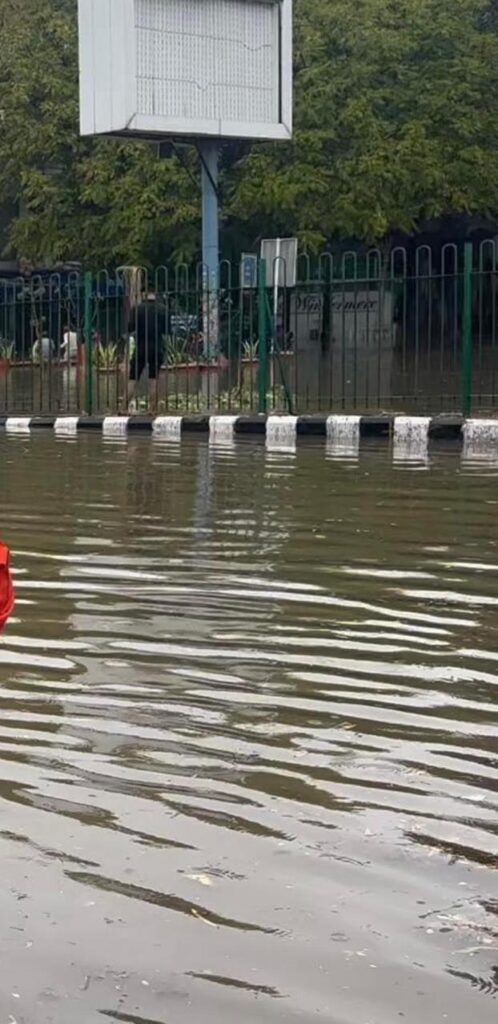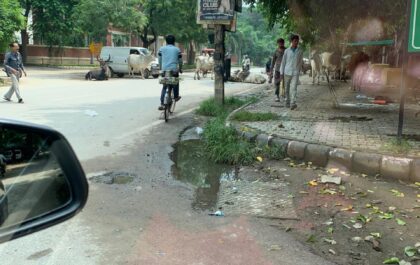As monsoon showers graced the city at the end of June, what should have been a welcome respite from the summer heat turned into a nightmare for the residents of S J Enclave, Green Park , and Arjun Nagar. The first major rain of the season brought knee-deep waterlogging that submerged entire neighborhoods, disrupting the daily lives of the residents and exposing serious civic issues.
Areas Affected
S J Enclave, Green Park , and Arjun Nagar were the hardest hit, with water entering basements and causing significant damage to personal property. The scenes were reminiscent of a flash flood, roads turned into rivers, and drains choked to the brim with rainwater and debris. The main drain at AIIMS, a critical point in the city’s drainage system, was completely blocked. This blockage triggered a catastrophic backlash of water that didn’t just affect AIIMS but also spread to Green Park, Gautam Nagar, Safdarjung Enclave, and Krishna Nagar.
Negligence in Drainage Maintenance
The primary cause of this large-scale waterlogging can be traced back to neglected maintenance activities by the civic authorities. Despite the approaching monsoon season, no de-silting was performed on time. The drains, crucial for redirecting rainwater away from residential areas, lay clogged and inefficient, thus causing overflowing and waterlogging.
Furthermore, encroachments by local residents and builders have significantly reduced the effective drainage capacity. Over time, many drains have been illegally built over or blocked, leaving rainwater with no proper outlet, thereby exacerbating the flooding problem.
Contributory Factors
1. Blocked Main Drain at AIIMS: The blockage at this critical point created a domino effect, with water backing up into the surrounding areas, compounding the waterlogging crisis across multiple neighborhoods.
2. Encroachments: Unauthorized construction over drainage infrastructure has left the city vulnerable to flooding during heavy rains. Residential properties and commercial buildings infringing upon these essential conduits act like bottlenecks in an already strained drainage system.
3. Civic Authorities’ Inaction: On the brink of the rainy season, the lack of timely desilting work stands out as a glaring oversight. Regular and preemptive maintenance of drains could have significantly mitigated the extent of the waterlogging.
Civic Response and Resident Frustration
Amid the deluge, civic authorities have come under intense scrutiny from frustrated and distressed residents, who had to deal with waterlogged homes, damaged property, and severely disrupted commutes. The inefficiency and negligence in handling pre-monsoon preparedness have drawn widespread criticism, with affected individuals demanding accountability and immediate remedial action.
The Way Forward
To prevent future episodes of such severe waterlogging, a multifaceted approach is essential:
– Regular Desilting Efforts: Civic bodies must implement and adhere to a strict schedule for drain cleaning, especially in the pre-monsoon phase.
– Enforcement of Anti-Encroachment Laws: Authorities need to rigorously enforce regulations against illegal constructions over drainage spaces.
– Community Awareness: Residents should be educated about the importance of keeping drains clear of debris.
The first rain of the monsoon season has thus served as a harsh reminder of the city’s infrastructural vulnerabilities. Effective and preemptive measures are imperative to safeguard against recurrent flooding and ensure that such an ordeal does not repeat in the future.

Popular Stories
Football Tournament @Princeton
More Than a Festival: The Art and Power of Durga Puja
Personality of the Month- ‘Dr Usha Mediratta’
Stray Cattle Menace In Front of Galleria
The Chronicles of Malibu Towne: A Mosquito’s Tale
“Senior Living Is Not An Old Age Home” say Mr & Mrs Bose
Recent Stories from Nearby
- Promises Repair of Broken Park Walls, Installation of Boom Barriers, Deep Cleaning of Drains… Among Other Things January 30, 2025
- Anand Niketan Club’s Grand New Year’s Eve Bash January 30, 2025
- Residents Come Together for a Night of Fun and Festivity January 30, 2025
- Rising Incidents of Harassment by Transgender Groups Raise Concerns in Delhi NCR January 30, 2025
- From Banana Races to Hurdles: ANRWA Sports Meet Had It All January 30, 2025







